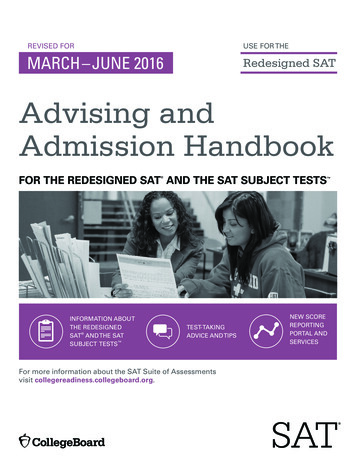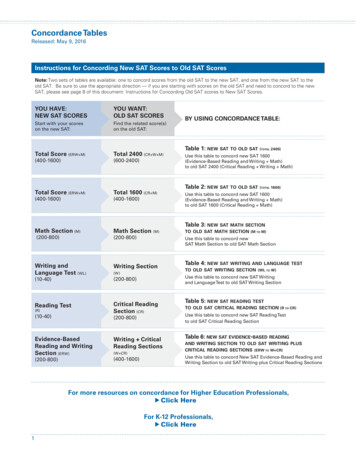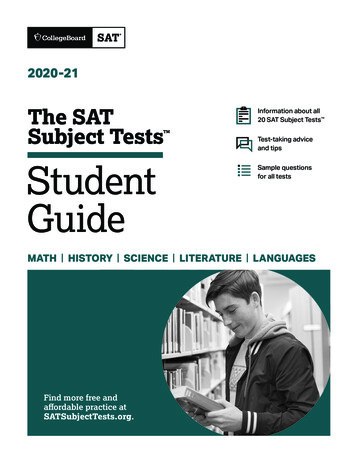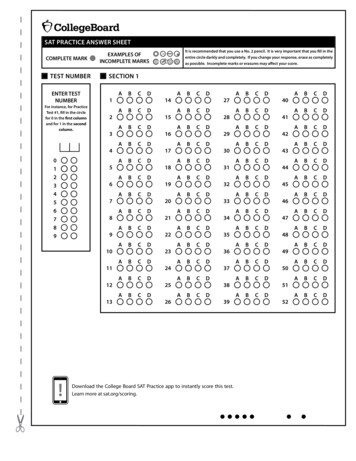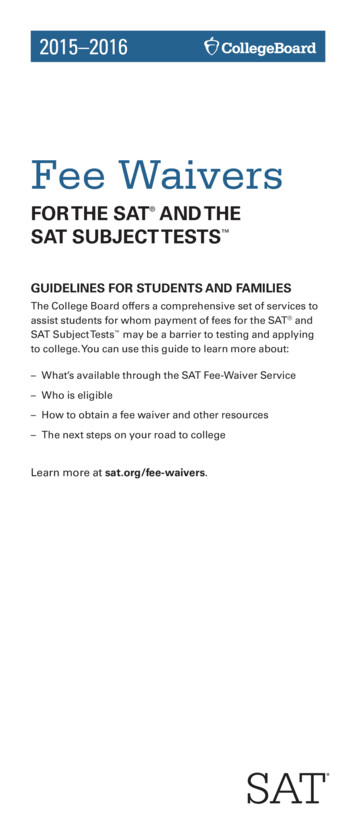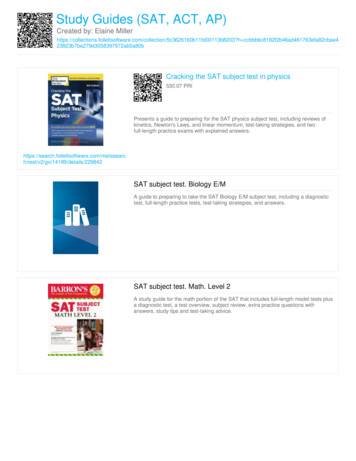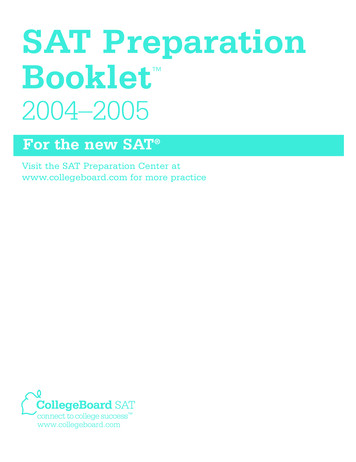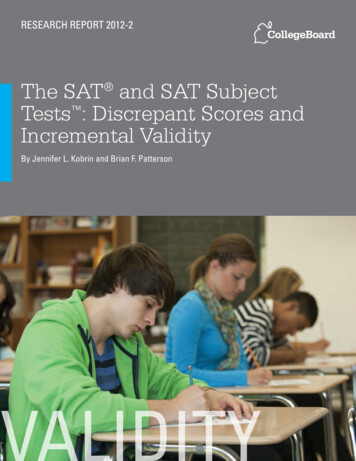
Transcription
Research Report 2012-2The SAT and SAT SubjectTests : Discrepant Scores andIncremental ValidityBy Jennifer L. Kobrin and Brian F. Patterson
Jennifer L. Kobrin is a research scientist at the College Board.Brian F. Patterson is an assistant research scientist at theCollege Board.AcknowledgmentsThe authors would like to thank Suzanne Lane and Paul Sackett fortheir helpful suggestions on earlier versions of this report.Mission StatementThe College Board’s mission is to connect students to college successand opportunity. We are a not-for-profit membership organizationcommitted to excellence and equity in education.About the College BoardThe College Board is a mission-driven not-for-profit organization thatconnects students to college success and opportunity. Founded in1900, the College Board was created to expand access to highereducation. Today, the membership association is made up of morethan 5,900 of the world’s leading educational institutions and isdedicated to promoting excellence and equity in education. Each year,the College Board helps more than seven million students preparefor a successful transition to college through programs and servicesin college readiness and college success — including the SAT andthe Advanced Placement Program . The organization also serves theeducation community through research and advocacy on behalf ofstudents, educators and schools.For further information, visit www.collegeboard.org. 2012 The College Board. College Board, Advanced Placement Program, AP,SAT and the acorn logo are registered trademarks of the College Board. SATReasoning Test and SAT Subject Tests are trademarks owned by the CollegeBoard. PSAT/NMSQT is a registered trademark of the College Board andNational Merit Scholarship Corporation. All other products and services maybe trademarks of their respective owners. Visit the College Board on the Web:www.collegeboard.org.VALIDITYFor more information on CollegeBoard research and data, visitwww.collegeboard.org/research.
ContentsExecutive Summary. 1Introduction. 2Purpose of the Study. 4Method. 5Data Sources. 5Analyses. 6Results. 8Gender Comparisons. 12Racial/Ethnic and Best Language Group Comparisons. 13Impact of Length of Time Between Tests and Order of Testing onthe SAT –Subject Test Discrepancies. 17Association of Academic Behaviors with Size of the Discrepancy. 18Prediction of FYGPA for Students with and WithoutDiscrepant Scores. 21Discussion. 25Summary and Conclusions. 27References. 29Appendix A. 30
TablesTable 1. Correlations of SAT and SAT Subject Test Scores for the 2006 College-BoundSeniors Cohort. 9Table 2. Percentages of Students in the Study Taking SAT and Subject Tests WithinGender, Race/Ethnicity, and Best Language Subgroups. 10Table 3. Mean Scores for SAT Subject Tests for the Study Sample and 2006 College-BoundSeniors Cohort. 11Table 4. Percentages of SAT and Subject Test Discrepancies for the Total Group. 12Table 5. Percentages of SAT and Subject Test Discrepancies by Gender. 13Table 6a. SAT and Subject Test Discrepancies by Racial/Ethnic Group: NumberTaking Both Tests. 14Table 6b. Percentages of Students by Racial/Ethnic Group with Higher Subject Test(SAT) Scores by at Least 100 Points. 15Table 7. Percentages of Students by Best Language with Higher Subject Test(SAT) Scores by at Least 100 Points. 16Table 8. SAT and Subject Test Discrepancies by Order of Testing. 17Table 9a. Mean Discrepancy Scores by Self-Reported Ability in Writing and Mathematics. 19Table 9b. Mean Discrepancy Scores by Self-Reported Average Grades. 20Table 9c. Mean Mathematics Discrepancy Scores by Self-Reported Course Taking. 20Table 10. Means (Standard Deviations) for SAT Scores, Subject Test Scores, HSGPA,and FYGPA by Discrepancy Groups. 22Table 11a. Increment in First-Year GPA Model R-Square Accounted for by SAT orSubject Test. 23Table 11b. Increment in First-Year GPA Model R-Square Accounted for by SAT Averageor Subject Test Average. 23Table 12a. Mean (SD) First-Year GPA Model Residuals for SAT and Subject Test Scoresby Discrepancy Group. 24Table 12b. Mean (SD) First-Year GPA Model Residuals for SAT Average and SubjectTest Average by Discrepancy Group. 24Table A1. Estimates of Standard Error of Difference (SED) and Effective SignificanceLevels (Eff.-α). 31
Discrepant SAT/Subject Test ScoresExecutive SummaryThis study examines student performance on the SAT and SAT Subject Tests in orderto identify groups of students who score differently on these two tests, and to determinewhether certain demographic groups score higher on one test compared to the other.Discrepancy scores were created to capture individuals’ performance differences on thecritical reading, mathematics, and writing sections of the SAT and selected Subject Teststhat were deemed the most comparable (such as the SAT critical reading section and theSubject Test in Literature; the SAT mathematics section and the Mathematics Level 1 andMathematics Level 2 Subject Tests). The percentage of students with discrepant scores wascompared for each SAT–Subject Test pair, overall and by gender, racial/ethnic, and best spokenlanguage subgroups. Next, the predictive validity of SAT and Subject Test scores for predictingfirst-year college/university grade point average (FYGPA) was compared for students with andwithout discrepant scores.The results demonstrate that the percentage of students with discrepant SAT and SubjectTest scores is small, especially for the tests that are most similar in terms of content.The validity of the SAT and SAT Subject Tests for predicting FYGPA varies according to theassessment on which a student scored higher relative to the other, and the pattern of resultsvaries for the different SAT–Subject Test pairs. In all cases, however, SAT and Subject Testscores each have incremental predictive power over the other. This study provides evidencethat each test provides distinct information that may be useful in the college admissionprocess. As such, joint consideration of these two test scores in college admission iswarranted.College Board Research Reports1
Discrepant SAT/Subject Test ScoresIntroductionThe SAT and SAT Subject Tests1 are both important and useful assessments in collegeadmission. The SAT measures the critical reading, mathematics, and writing skills that studentshave developed over time and that they need to be successful in college. Students take the SATSubject Tests to demonstrate to colleges their mastery of specific subjects. The College Board’sSAT Program offers 20 Subject Tests in five general subject areas: English, history, mathematics,science, and languages. The content of each Subject Test is not based on any single approach orcurriculum but rather evolves to reflect current trends in high school course work.There are conflictingmessages in themedia, in the body ofexisting psychometricresearch, and amongeducators regardingthe relative meritof the SAT and theSubject Tests.SAT Subject Tests are taken by a smaller and moreselect population of students compared to thosewho take the SAT. Among the high school seniorswho graduated in 2008, more than a million and ahalf students took the SAT, whereas slightly fewerthan 300,000 took at least one SAT Subject Testand 275,714 students took the SAT and at least oneSubject Test. The mean SAT scores for studentstaking both tests were 590 in critical reading, 618in mathematics, and 593 in writing, which areconsiderably higher than the mean scores for thefull SAT cohort (which scored 502, 515, and 494,respectively). Of those taking at least one SubjectTest (without necessarily taking the SAT), 8% ofstudents take one Subject Test, 41% take two,another 41% take three, and 11% take four or moreSubject Tests. Among the SAT takers who graduatedin 2008, the Subject Tests with the highest volumewere Mathematics Level 2 (150,352 test-takers),U.S. History (123,475), Literature (119,180), andMathematics Level 1 (91,225). The volumes for theother Subject Tests among the students graduating in2008 ranged from 505 (Modern Hebrew) to 62,263(Chemistry) test-takers (College Board, 2008).The SAT tests students’ knowledge of reading, writing, and mathematics, as well as theirability to apply that knowledge. It is a broad survey of the critical and quantitative thinkingskills students need to be successful in college, regardless of the specific subject areas onwhich that student may decide to focus. The Subject Tests are high school–level, contentbased tests that allow students to showcase achievement and demonstrate interest inspecific subject areas, including some that are not assessed on the SAT, such as science,history, and languages.There are conflicting messages in the media, in the body of existing psychometric research,and among educators regarding the relative merit of the SAT and the Subject Tests. Over thepast several years, a host of prominent educators and researchers, including Howard Gardner,Michael Kirst, and former University of California (UC) President Richard Atkinson, have voiced1. The SAT Subject Tests were formerly called SAT II tests, and before that, SAT Achievement Tests. The SATwas previously referred to as the SAT Reasoning Test and prior to that, the SAT I. Despite the changes in thenames of the tests, the knowledge and skills assessed did not substantially change (other than the addition ofa writing test to the SAT). In this report, when prior research on the SAT and Subject Tests is discussed or cited,the test name is that used at the time the studies were conducted.2College Board Research Reports
Discrepant SAT/Subject Test Scorestheir preference for college admission tests to be more closely tied to high school and collegepreparatory curricula (Zwick, 2002). Some have voiced their belief that the Subject Tests mayidentify bright students who have not yet mastered the English language (see Tran, 2008).Harvard University’s dean of admissions has said that Subject Tests are “better predictorsthan either high school grades or the SAT” (Mattimore, 2008).On the other hand, the University of California recently approved a policy eliminating SATSubject Tests from admission requirements, although individual colleges and departmentsstill have the option to recommend submission of specific SAT Subject Test scores. Inmaking their argument for eliminating the Subject Test requirement, the university’s Board ofAdmissions and Relations with Schools (BOARS) cited research showing that after accountingfor high school grade point average (HSGPA) and SAT scores, Subject Test scores contributedvery little to the accuracy of predictions of initial success at the UC. Their research showedthat introducing SAT Subject Tests into a regression model that already included the SATincreased the percent of variance of FYGPA explained by only 0.2% to 0.5%, dependingon the other variables included in the model (Agronow & Rashid, 2007). These analyses didnot consider the fact that because the SAT and SAT Subject Tests are highly correlated, aregression model that includes both measures introduces multicollinearity into the model.In these situations, multicollinearity can lead to inflated regression parameter standarderrors and erratic changes in the signs and magnitudes of the parameters themselves, givendifferent orders of entry of predictors into the model. As a result, studies such as thoseconducted by UC researchers that compare the regression coefficients of highly correlatedpredictors may result in incorrect conclusions.BOARS also claimed that eliminating the Subject Test requirement would broaden the pooland increase the quality of students who are visible to the university’s admissions processes.This research conflicts with earlier findings by UC researchers showing SAT II scores as thesingle best predictor of FYGPA for students entering the UC from fall 1996 to fall 1999, andshowing that SAT I scores added little to the prediction once SAT II scores and HSGPA hadalready been considered (Geiser & Studley, 2001; 2004).Shortly after the Geiser and Studley (2001) study was released, Kobrin, Camara, and Milewski(2002) examined the relative utility and predictive validity of the SAT I and SAT II for varioussubgroups in both California and the nation. Analyzing data from the 2000 College-BoundSeniors cohort, they found that if the SAT II (writing2, either level of Mathematics, and a thirdtest of each student’s choice) was to be used without the SAT I, the impact (i.e., the differencebetween the mean SAT II score for white students and the mean score for each minoritygroup) would be slightly reduced for African American, Hispanic, and Asian American studentsin this sample, with the greatest reduction being for Hispanic students. The absolute scoredifferences in composite means between the SAT I and SAT II were quite small for all groups.On average, white and African American students scored slightly higher on the SAT I thanon the SAT II (13 and 11 points on a 200- to 800-point scale, respectively), Hispanic studentsscored higher on average on the three SAT II tests than on the SAT I (26 points), and there wasno difference among Asian American students’ SAT I and II scores. Whites, African Americans,and English speakers with differences in test performance were more likely to score higheron the SAT I than on the SAT II tests (writing, mathematics, and any third test), whereasAsian Americans, Hispanics, and non–English speakers with differences in test performancegenerally scored higher on the SAT II tests.2. The SAT II Writing Test was the predecessor to the SAT Writing section; it is no longer in existence.College Board Research Reports3
Discrepant SAT/Subject Test ScoresAnalyzing data from first-time students entering college in 1995 at 23 colleges anduniversities across the United States, Kobrin, Camara, and Milewski (2002) found that theSAT II tests had marginally greater predictive validity for predicting FYGPA than the SAT I forethnic groups other than American Indians and African Americans. Similarly, the combinationof HSGPA and three SAT II tests had slightly greater predictive validity than the combinationof HSGPA and the SAT I for all ethnic groups except American Indians and African Americans,although Bridgeman, Burton, and Cline (2001) pointed out that a result such as this may beattributed to comparing three SAT II tests to two SAT I tests. In other words, more test scoresare expected to predict an outcome better than fewer. The SAT I had a positive incrementalvalidity over HSGPA and the SAT II tests for three of the six ethnic groups, and the SAT IItests added to the predictive validity of HSGPA and the SAT I for all ethnic groups. When theSAT II (writing, mathematics, and a third test) was used to predict FYGPA, Hispanic students’GPAs were overpredicted (i.e., the regression model predicted a higher GPA on average thanthese students actually obtained) to a greater extent than when the SAT I was used as apredictor. The pattern of prediction remained similar for the other racial/ethnic groups whetherthe SAT I, the SAT II, or both were used.In terms of the practical implications of substituting Subject Test scores with SAT scores,or vice versa, Bridgeman, Burton, and Cline (2001) simulated the effects of making collegeselection decisions using SAT II scores in place of SAT I scores. While success rates in termsof FYGPA were virtually identical whether SAT I or SAT II scores were used, slightly moreHispanic students were selected with the model that used SAT II scores in place of SAT Iscores. Scores on the SAT and SAT Subject Tests are moderately to highly correlated, so formost students the same decisions would be made using either test.Purpose of the StudyGiven the current debate on the relative merits of the SAT and SAT Subject Tests, the purposeof this study is to examine student performance on the SAT and Subject Tests, to identifystudent groups that score differently on these two tests, and to determine whether therelationships of the two sets of tests with college grades vary for students who score higheron one test over the other. The research questions addressed in this study are as follows:1. Of the students who take the SAT and a Subject Test of similar content, how manystudents score substantially higher on one test compared to the other?2. What type of student (by gender, race/ethnicity, best language, and academic ability) ismore likely to score substantially higher on the SAT compared to a Subject Test? On aSubject Test compared to the SAT?3. Are discrepancies between the SAT and Subject Tests more pronounced when studentstake the tests farther apart in time?4. Are there academic behaviors (such as high school course selection) that are associatedwith the size of the discrepancy?5. Does the predictive validity of the SAT and Subject Tests for predicting FYGPA vary forstudents who score substantially higher on one test over the other?Ramist, Lewis, and McCamley-Jenkins (2001) conducted similar research using data onfreshmen entering 39 colleges in 1982 and 1985. They compared the performance of studentswho took an SAT Achievement Test (the former name for the SAT Subject Tests) with their4College Board Research Reports
Discrepant SAT/Subject Test Scoresperformance on the SAT verbal section (for Achievement Tests in English, history, andlanguages), the SAT mathematics section (for Achievement Tests in mathematics), or the sumof the verbal and mathematics scores on the SAT (for Achievement Tests in natural scienceand the average of all of a student’s Achievement Test scores). To maximize the sample sizefor all comparisons, scores for freshmen enrolling in 1982 and 1985 were combined. Ramist,Lewis, and McCamley-Jenkins compared the standard scores on the SAT and AchievementTests; the standard scores were computed as the difference between the mean for a studentgroup on the test and the mean for all students on the test, divided by the standard deviationfor all students. Students who had indicated that English was not their best language stoodout as achieving much higher scores on the Achievement Tests compared to the SAT, withstandard score differences of 0.25 or more between the related SAT section(s) and theSpanish, French, European History, Physics, American History, and Chemistry AchievementTests, as well as the average score on all Achievement Tests.MethodData SourcesThis study included two phases, each based on a different sample. The first phase of thestudy was descriptive in nature and was based on the 2006 College-Bound Seniors cohort.This group consists of the students who took the SAT and reported plans to graduate fromhigh school in 2006. All analyses in this study were based on the students who took theSAT and at least one of the Subject Tests under study (N 245,602): Literature, AmericanHistory, World History, Mathematics Level 1, Mathematics Level 2, Chemistry, Physics,Ecological Biology, and Molecular Biology. The Subject Tests in languages were not includedin this study, except in the computation of a mean Subject Test score that will be discussedlater. (Approximately 25% of the students in the sample took at least one language SubjectTest.) The most recent scores were used for students with multiple testing results. The SATis composed of three sections: critical reading (SAT-CR), mathematics (SAT-M), and writing(SAT-W). The score scale range for each section is 200 to 800; each Subject Test also has ascore scale range of 200 to 800. The scaling of the Subject Tests is performed in such a wayas to reflect the ability of the groups taking each test.3 The result is that the scales for each ofthe different Subject Tests are comparable with each other as well as with each of the threesections on the SAT (for more information on the scaling of the SAT and Subject Tests, seeDonlon, 1984 and Angoff, 1971). Students’ self-reported gender, race/ethnicity, best language,HSGPA, average course grades, and course-taking information (e.g., the number of years ofnatural science taken in high school) were obtained from the SAT Questionnaire completed bystudents during registration for the SAT.The second phase of the study compared the predictive validity of SAT and Subject Testscores for predicting FYGPA for students overall and with and without discrepant scores.This research was based on the data collected in the National SAT Validity Study described inKobrin, Patterson, Shaw, Mattern, and Barbuti (2008). The data included SAT scores, students’3. Scaling procedures for the Subject Tests were developed to adjust the scales so that they reflect the leveland dispersion of ability of those taking the test. These procedures employed multiple regression techniquesusing SAT scores as predictors, or covariates. (Some of the language Subject Tests also included years of studyas a covariate.) Test performance was estimated for a hypothetical reference population whose members neveractually took all Subject Tests. This population, the 1990 reference population for recentered SAT I scales, wasdefined with a mean of 500 and a standard deviation of 110 (the scale used for the recentered SAT scale) onboth the SAT verbal and mathematics sections. The Subject Tests were placed on the same scale by linearlytransforming the estimated performance of the SAT reference group on each test to a mean of 500 and astandard deviation of 110 (R. Smith, personal communication, January 27, 2003).College Board Research Reports5
Discrepant SAT/Subject Test Scorescourse work and grades, and FYGPA for the fall 2006 entering cohort of first-time students(N 195,099) at 110 colleges and universities across the United States. The range of FYGPAacross institutions was 0.00 to 4.27, with most institutions’ grades ranging from 0.00 to 4.00.AnalysesDiscrepancy scores were created to capture individuals’ performance differences onthe relevant sections of the SAT and certain Subject Tests that were deemed the mostcomparable by the authors in terms of the subject matter and skills assessed. The SAT–Subject Test comparisons included the following: SAT critical reading section versus SAT Subject Tests in U.S. History, World History, andLiterature SAT writing section versus SAT Subject Tests in U.S. History, World History, and Literature SAT mathematics section versus SAT Subject Tests in Mathematics Level 1, MathematicsLevel 2, Chemistry, Physics, Ecological Biology, and Molecular Biology SAT (average across sections) versus SAT Subject Tests in Chemistry, Physics, EcologicalBiology, and Molecular Biology4 SAT (average across sections) versus Subject Test average (separate analyses, eitherincluding or excluding the language Subject Tests)The SAT average was computed as the average of the SAT-CR, SAT-M, and SAT-W sectionsfrom the latest single administration. The SAT average was also compared with two SubjectTest averages: The first included all Subject Tests except for the language Subject Tests, andthe second included all Subject Tests that were taken. If a student took only one Subject Test,that score was compared with the SAT average. These comparisons were made to provide anoverall assessment of discrepancies between students’ performance on the SAT and SubjectTests.The Subject Tests in the natural sciences (Chemistry, Physics, Ecological Biology, andMolecular Biology) were compared to the SAT mathematics section and to the SAT average.Ramist, Lewis, and McCamley-Jenkins (2001) compared the natural science AchievementTests to the SAT composite, arguing that the science tests required both verbal andmathematical skills. On the other hand, due to the growing interest in and emphasis on STEM(science, technology, engineering, and mathematics) education, direct comparisons betweenthe SAT mathematics and the Subject Tests in natural sciences were also included. TheSubject Tests in History, Literature, and Mathematics were not compared to the SAT averagebecause each of these Subject Tests requires predominantly verbal or mathematical skills, butnot both.4. It is noted that, when comparing the SAT average with any single Subject Test, one may expect a largernumber of discrepancies because the standard error of the Subject Test is expected to be larger than thestandard error of the SAT average. In other words, because the SAT average is based on an exam approximatelythree times longer than the Subject Test, the Subject Test scores are likely to contain a greater amount ofmeasurement error.6College Board Research Reports
Discrepant SAT/Subject Test ScoresEach student’s Subject Test score was subtracted from his or her SAT score.5 The resultingdiscrepancy scores across all SAT–Subject Test pairs ranged from -600 to 450, and the meandiscrepancy scores ranged from -11.1 (for the SAT average compared to the Subject Testaverage, including language tests) to 40.9 (for the SAT-M compared to the Subject Test inPhysics).The first set of analyses was based on the 2006 College-Bound Seniors cohort and includeddescriptive statistics on students taking each SAT–Subject Test pair. Students with scoresdiffering by less than 100 points on the pair of tests were classified as nondiscrepant, andstudents scoring at least 100 points higher on one test were classified as discrepant. Threegroups were formed: 1) students with no discrepancy; 2) students scoring higher on theSubject Test; and 3) students scoring higher on the SAT. The percentage of students in eachgroup was compared for each SAT–Subject Test pair, overall, and by gender, racial/ethnic,and best language subgroups. The percentage of students in each group was also comparedbased on whether the SAT or Subject Test was taken first (i.e., the order of testing).A discrepancy score of at least 100 points was used to define the discrepancy groupsbecause this is the approximate standard deviation of scores in the College-Bound Seniorscohort for each Subject Test. Since scores on any test are not perfect indicators of students’ability and contain some error, Appendix A shows how the standard error of the difference(SED) was used to assess to what extent scores on the SAT and Subject Test must differ inorder to reflect true differences in ability. In particular, it shows the significance levels for eachSAT–Subject Test comparison implicit in the use of 100 points as the criterion for identifyingdiscrepant scores.The second phase of research involved an investigation of the validity of SAT and SubjectTest scores in predicting FYGPA for students in each of the three discrepancy groups. Theremainder of this paper describes additional analyses conducted on only the three mostsimilar SAT–Subject Test pairs. Three separate regression equations were computed: oneusing either the critical reading or mathematics section of the SAT to predict FYGPA, thesecond using Subject Test scores to predict FYGPA, and the third using both SAT and SubjectTest scores to predict FYGPA. The increment in the variance of FYGPA accounted for by eachtest over the other, and the average residuals (residual actual FYGPA - predicted FYGPA),were
SAT Subject Tests are taken by a smaller and more select population of students compared to those who take the SAT. Among the high school seniors who graduated in 2008, more than a million and a half students took the SAT, whereas slightly fewer than 300,000 took at least one SAT Subject Test and 275,714 students took the SAT and at least one


